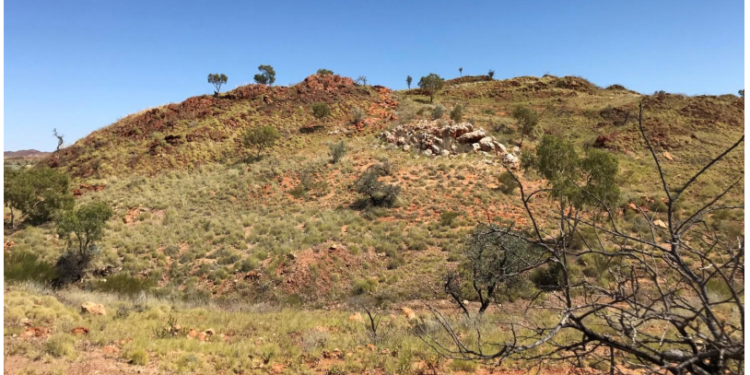Eastern Resources Limited (ASX:EFE) has mapped significant number of pegmatite outcrops over an area of 3km strike by up to 1.2km in the Trigg Hill Lithium-Tantalum Project in Western Australia.
The detailed mapping at the former Trigg Hill tantalum-tin mine has enabled an understanding of the orientation and zonation of the LCT pegmatites which are the source of mined formanite (tantalumyttrium oxide) and cassiterite (tin oxide).
Traverse mapping on the Curlew swarm of pegmatites has confirmed that a large number of pegmatites occur over at least 3km of strike and up to 1.2km in width east of the excluded Curlew emerald mine. Some of these pegmatites were visually confirmed to contain lepidolite (lithium mica) and formanite.
Confirmation of the presence of spodumene, if present, will require further analysis. Rock chip samples were collected with assay results pending. Mapping and sampling continues on the Curlew pegmatite swarm.
Trigg Hill Lithium-Tantalum Project
The Trigg Hill Project is located in East Pilbara, Western Australia and approximately 75km SE of Pilbara Minerals Ltd’s Pilgangoora Lithium mine and 77km SE of the Wodgina Lithium and Tantalum mine. The existing port of Port Hedland is approximately 225km away by road.
The Trigg Hill mine is an old tantalum and tin mine operated during the 1960s and early 1980s. Pegmatite outcrops occur within the Trigg Hill–Curlew pegmatite swarms covering approximately five sq. km with a known lithium occurrence.
The company executed a binding Heads of Agreement to acquire 100% interest in the Trigg Hill Project in August 2021.
Field Work
At Trigg Hill an area 800m x 500m was mapped in detail, with numerous pegmatites intruding the greenstone. The nature of the pegmatites allows loose groupings based on both location and attitude. In the central part of the hill at Trigg Hill, there is a northwest to north-south trending major pegmatite, with steep dip, that has a number of thin splays, with the company believing that this pegmatite is probably fractionated.
To the north and east of this, the pegmatites invariably strike northerly and have steep dips, however, vary significantly in thickness and appear to have complex bifurcating geometries. The East Curlew lepidolite pegmatite previously sampled by Lithium Australia (ASX: LIT) up to 2.9% Li2O1 extends for 1,800m and straddles the border between the excised Curlew emerald mining lease and E45/5728 and dips east into E45/5728.
In the south and west of the Trigg Hill area, the pegmatites are variably flat lying to shallow dipping, with a thin pegmatite ‘sill’ that defines the contact between the granite gneiss and greenstones. Above this, there is another effectively flat lying fractionated pegmatite.
The complex topography leads to a complex web pattern of outcrops, however it is likely that the distribution of the pegmatite reflects a single flat lying body. In the ‘main’ area of Trigg Hill workings, there are distinct massive quartz cored pegmatite outcrops which appear to have an east-west strike with a moderate to steep (50° – 60°) south dip.
Based on recent and prior exploration the most prospective area for fractionated LCT pegmatites extends for 600m by 280m. Drilling has recommended to test the larger, centrally located, moderate to steep dipping pegmatites and the relatively narrow flat lying pegmatites and for potential hidden parallel, flat lying pegmatites within the greenstone above the gneiss contact.
Traverse mapping of the Curlew pegmatite swarm was successful in locating numerous pegmatites over an area of 3km along strike and 300m to 1.2km across strike. The pegmatites vary in width, dip and mineralogy. A number of the more extensive pegmatite dykes in the Curlew pegmatite swarm appear to be interconnected.
Field work in March and April 2022 visually confirmed the presence of LCT pegmatites containing lepidolite (lithium mica) and formanite, which is consistent with historic work. The presence of previously reported1 lithium mineral; spodumene has not yet been confirmed and will require analytical or XRF identification.
Further works
Field mapping and sampling is continuing on the Trigg Hill Project from the second half of April and to the first week of May with the aim of defining drill targets. Additional samples have been collected and will be delivered to laboratory in May for assays.
Assay results and XRD analysis for rock chip samples collected in March are expected at the end of May. A PoW proposal has been lodged and is pending approval. Phase 1 drilling of 2,000m planned in July 2022 pending on PoW approval, targeting at both spodumene and lepidolite.
For further information please visit: http://easternresources.com.au/












